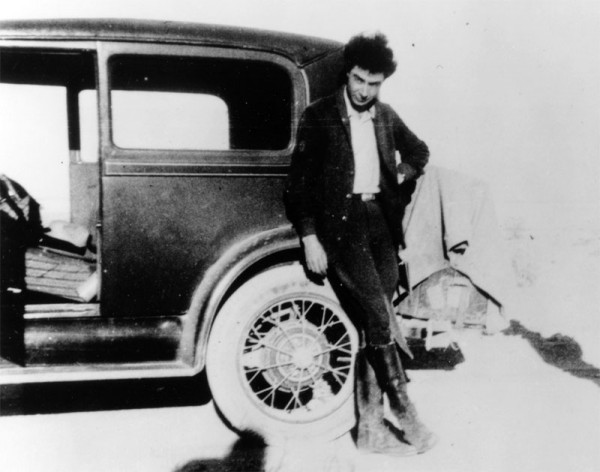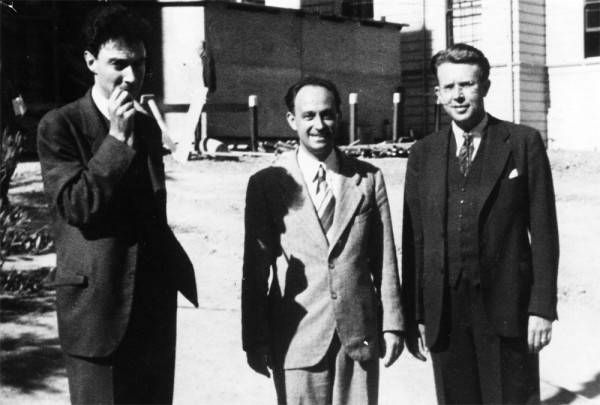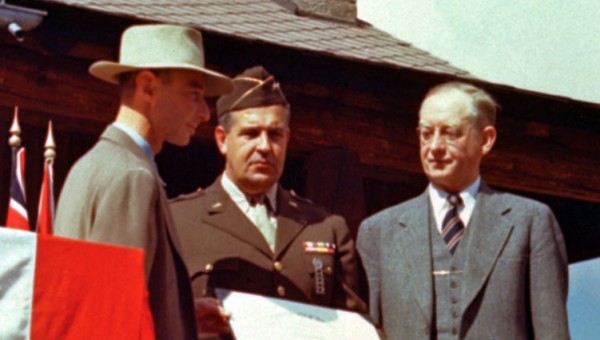The latest episode of Manhattan (Ep. 204) pivoted on the internal conflicts of J. Robert Oppenheimer. The standard, popular version of Oppenheimer as Los Alamos Director is one of infinite competence, confidence, and charm. The reality of Oppenheimer as a whole, much less Oppenheimer at Los Alamos, is a far more complex one.
Early on in my education, one of my advisors warned me against careless labeling of historical actors as “complex” or “complicated” without explaining what exactly I meant by that. In this sense, I think what it means is, this is a person who acts in contradictory, not-always-predictable ways — a person who breaks the standard narrative arc we might want to tell about their life. Oppenheimer is someone whose close examination refuses to fit into a simple narrative of heroism, tragedy, or comedy. In other words, he was a real person. And as T.H. White put it: “It is difficult to write about a real person.”

Oppenheimer as rich-rugged-cowboy-Hindu-Jewish-intellectual. At his ranch, “Perro Caliente,” with Ernest Lawrence (cropped out of frame) in 1931. Source: Emilio Segrè Visual Archives.
Oppenheimer’s longtime friend, the physicist I.I. Rabi, later said that the core conflict of Oppenheimer’s personality was a search for identity. It was a perceptive remark. As to which of the many visible Oppenheimers was the “real” one, he suggested that, “Robert doesn’t know himself.” Oppenheimer was, Rabi would later put it, “a man who was put together of many bright shining splinters.”1
Consider the oft-told Oppenheimer biographical details in this light. Oppenheimer grew up on the Manhattan’s Upper West Side, in a family of wealthy, secular, German-Jewish immigrants. This, in and of itself, seems to have driven a lot of Oppenheimer’s initial search for a new identity. He apparently was embarrassed by his father’s hands-on approach to wealth (he was a textile merchant, so nouveau riche of a sort), embarrassed by his father’s approach to secularism (his enthusiastic embrace of Felix Adler’s Ethical Culture philosophy), and simultaneously embarrassed by his Jewishness. He went to Harvard during one of its peak moments of anti-Semitism (the year he started was marked with embroiled public discussions about Harvard’s Jewish quotas), and found himself a socially-awkward exile among blue-bloods from old-American families.
His escape from the identity he was born into was to embrace something entirely different. He found friends who to him represented what a “true American” intellectual might look like — rugged, earthy, wealthy men from New Mexico. Hence Oppenheimer’s great Southwestern obsession, the one that led to the Los Alamos laboratory being situated where it was. What is more of an antonym to “rich Manhattan Jewish German immigrant” than “rugged Southwestern cowboy”? His interest in Hinduism, Sanskrit, and the Bhagavad-Gita might be filed under this antonymic approach to identity as well: leaving behind both the traditional sacred of his heritage (Jewishness) and the Western secularism of his upbringing (Ethical Culture) by embracing the oriental mysticism of Far Eastern philosophy.

Oppenheimer, Enrico Fermi, and Ernest Lawrence at UC Berkeley, ca. 1939. Note that Oppenheimer has clearly not yet taken on the identity of Scientific Director yet — too much hair. All three of these physicists would eventually recommend dropping the atomic bomb on a civilian target. Source: Emilio Segrè Visual Archives.
One of the more puzzling episodes in Oppenheimer’s life is related to ones of these identity crises. After graduating from Harvard, Oppenheimer went abroad to continue his physics education as a graduate student. He choose his initial venue poorly: he went to Cambridge, in England, where the kind of physics they were interested in was not to his liking (he was doing experimental physics, and he was terrible at it), and he found British class culture even more exclusive and stifling than Harvard’s had been. Oppenheimer experienced a series of crises and failures. The culmination of one of these involved him rushing back to Cambridge, telling his friends that he had laid a “poisoned apple” on the desk of the physicist P.M.S. Blackett. Blackett represented everything Oppenheimer could not be in England: successful experimentalist, movie-star handsome, and well-integrated into British class society. Was this “poison” real, imagined, or metaphorical? Nobody is quite sure — Blackett apparently suffered no physical ill, in any case.
Oppenheimer overcame this crisis and found a way forward, eventually by leaving England and studying instead on the European continent. There he learned the new theoretical physics (quantum mechanics), which he excelled at and emerged as an admired wunderkind. It was in this period, on the continent, that the character of “Oppie” (originally “Opje” in Dutch) was created: mathematically and physically adventurous, confident, quick-witted, eccentric, intellectually ambidextrous.
This trying-on of identities can help explain some of Oppenheimer’s wartime behaviors as well. Oppenheimer-as-Scientific-Director was on of his most successful costume changes, in retrospect, but it was a daring risk for him. General Groves gave him the job despite the fact that Oppenheimer lacked any real administrative experience, much less any practical experience in building anything. Oppenheimer also had extreme liabilities in his past and present: one of his identities in the 1930s had been of a “fellow traveler” to many Communists and Communist-associates in his life, including, but not limited to, his wife (Kitty), his brother (Frank), his friends (Haakon Chevalier), his girlfriend and later mistress (Jean Tatlock — more on her in a future post), and his graduate students.

Oppenheimer, General Leslie Groves, and University of California President Robert Sproul, at the Army-Navy “E” Award ceremony in October 1945, recognizing the work of Los Alamos in developing the first atomic bombs. Source: Los Alamos National Laboratory.
These liabilities were known by Groves and others in the Manhattan Project security apparatus. They may have been one of the reasons Oppenheimer was an appealing choice for the job — he was moldable, he was relatively compliant, and these liabilities gave them leverage, should they need it. Oppenheimer worked so hard to be successful at this newest identity (creator of weapons of mass destruction for the U.S. government) that he overcame his past hang-up of leaving scientific investigations half-finished. He did have such doubts at times that he considered resigning, but he was talked out of the notion by his friends. He cut his hair, and got the job done.
The only trade-off was that in order to assume this new role, he had to prove his loyalties, and he did that by selling out his friends and colleagues. In many of the lengthy FBI files on his students and friends, one can find, very early in the file, an account of how they got on the radar of the anti-Communist agents of the United States government: they were alerted by J. Robert Oppenheimer himself. To be sure, Oppenheimer usually prefaced his denunciations by saying that these people were harmless, but he named names nonetheless.2
Ultimately it was this conflict of identities, I think, that snared Oppenheimer himself, in the end. His own well-documented downfall in the mid-1950s was in part the conflict of two of his identities. One of them was an eccentric, politically left-leaning intellectual who could be friends with anyone and dared to think and say whatever came to mind. The other was the head of a government weapons laboratory and later top-advisor in the area of nuclear arms. For a brief moment during the Manhattan Project, these two identities could overlap. By the 1950s, they could not — they were mutually exclusive, as distinct as a wave and a particle. Oppenheimer’s attempts to embody both of these at the same time, a sort of Complementarity-of-the-self, resulted in his selling out of the ideals of the former, and being rejected by the fears of the latter.
- These quotes are from Charles Thorpe’s Oppenheimer: The Tragic Intellect (Chicago: University of Chicago Press, 2006), 16. Thorpe’s book devotes much of its study of Oppenheimer to his quest for identity, and I owe many of my thoughts here to Thorpe’s work. [↩]
- To put this into perspective for my students, I tell them to replace the label “Communism” with “terrorist,” and imagine how it would go over with the FBI today if you told them that a friend of yours was a little bit of a terrorist in the past, but had seen the error of their ways and was fine now. Would the FBI be comforted? Of course not. [↩]



Good article thank you. I like the people centric ones. Looking into the psyche of the collective. Keep up the good work.
As usual, an excellent post. I would note that the two (or even more) identities alone did not lead to Oppenheimer’s tragedy; it was that they provided resources for his critics and enemies to use to achieve their own ends, one of which was ruining him. Strauss and Teller, among others, had their own agenda and Oppenheimer’s past and his rather complex form of self-fashioning–what your post is about–afforded them multiple opportunities.
I was also struck about how the story of the poisoned apple resonates not only with the fairy tale, but Turing’s final act.
Again, thanks for such a rich and thoughtful piece.
Of course, there were many other, proximate causes for Oppenheimer’s downfall. But what made him so vulnerable to attack were these contradictions, which, under intense scrutiny, looked like dangerous character defects (“Because I was an idiot”).
I think identity issues were not unrelated to the animosity felt by Strauss in particular towards Oppenheimer, either. Oppenheimer’s repudiation of his Jewishness, his inherited wealth, and his intellectual pretensions probably played no small part in Strauss’s turning what might be a difference of political opinion into a personal vendetta that survived long after Oppenheimer was no longer politically in Strauss’ way. Strauss’ biography presents a marked contrast to Oppenheimer: no formal education, observantly Jewish, grew up poor in the South, self-made businessman, etc.
I think one of the reasons Oppenheimer continues to be fascinating to many of us is because his search for identity mirrors our own. Each one of us struggles to find his or her identity in a complex world; some of us succeed, but most of us keep struggling to varying extents. In Oppenheimer we see ourselves.
I admire this post not only for its main points but also for this note: “Early on in my education, one of my advisors warned me against careless labeling of historical actors as ‘complex’ or ‘complicated’ without explaining what exactly I meant by that.” As soon as I read that, I recalled that I had used the word “complex” in just such an unclear way a few hours ago, and I promptly revised my text. Thanks.
Alex, you mention Thorpe’s book in your notes. Not having thoroughly surveyed the Oppenheimer lit, do you find that different authors who analyze JRO’s psychology, such as Sam Schweber in his parallel lives book with JRO and Bethe, take a different approach or come to different conclusions?
I’m always intrigued by the poison apple story, since in my work I deal more with Blackett than with Oppenheimer, and their World War II stories are both very interesting but don’t intersect much. I believe when they were at Cambridge, Blackett was also part of an intellectual circle with Peter Kapitsa and a couple of others. Is it known, did JRO get involved with that at all?